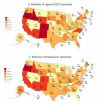(Press-News.org) St. Jude Children's Research Hospital scientists have discovered an enzyme that regulates production of the toxins that contribute to potentially life-threatening Staphylococcus aureus infections. The study recently appeared in the scientific journal the Proceedings of the National Academy of Sciences (PNAS).
Researchers also showed that the same enzyme allows Staphylococcus aureus to use fatty acids acquired from the infected individual to make the membrane that bacteria need to grow and flourish. The results provide a promising focus for efforts to develop a much-needed new class of antibiotics to combat staph and other Gram-positive infections. Staphylococcus aureus is the most common cause of staph infections, including methicillin-resistant Staphylococcus aureus (MRSA), the drug-resistant infection that is a growing problem in hospitals.
"Staphylococcus aureus is a clear and present danger to patients worldwide," said corresponding author Charles Rock, Ph.D., a member of the St. Jude Department of Infectious Diseases. "We set out to answer a long-standing question about bacterial membrane biochemistry and discovered a master regulator of the virulence factors that make staph infections so destructive and dangerous. The pathway we identified offers an exciting new target for antibiotic drug development."
Virulence factors include dozens of proteins that bacteria make and secrete. The factors cause many symptoms and infection-related problems, including destruction of cells and tissue, and evasion of the immune system.
The enzyme Rock and his colleagues discovered is fatty acid kinase (FAK). Researchers showed that FAK is formed by the proteins FakA and FakB1 or FakB2. Scientists demonstrated how FakA and FakB work together to replace fatty acids in the bacterial membrane with fatty acids from the person infected.
Fatty acids are a key component of the phospholipids that make up a significant part of the bacterial membrane. Bacteria produce their own fatty acids, but some, including Staphylococcus aureus, can also borrow from their host, which reduces the demands on bacteria to make their own. Until now, however, the enzyme used to incorporate host fatty acids was unknown.
Researchers showed that different genes carry instructions for making the FAK proteins. Loss of the genes disrupted the ability of bacteria to incorporate host fatty acids into the bacterial membrane. "The big surprise was that loss of these genes also impacted production of virulence factors," Rock said. "The mutant Staphylococcus aureus did not make the proteins responsible for many of the symptoms caused by these infections."
Earlier research from Rock hinted at a connection between fatty acid synthesis and production of virulence factors, but this study is the first to establish the biochemical link and identify the mechanism involved. Evidence suggests that FAK functions in the transcriptional regulation of virulence factor production, switching on genes that carry instructions for making the proteins. "In fact, FAK's primary role in bacteria might be as a transcriptional regulator," Rock said.
Researchers also detailed how FAK handles its duties related to membrane phospholipids. FakA includes the kinase domain, which allows the protein to function as an enzyme. FakB1 binds saturated fatty acids while FakB2 prefers unsaturated fatty acids.
When FakA interacts with either FakB1 or FakB2 a phosphate is transferred onto the FakB fatty acid, producing acyl-phosphate, a chemical intermediate not found in humans. The acyl-phosphate is used as a substitute for fatty acids normally made by the bacteria.
The paper's first author is Josh Parsons, Ph.D., a postdoctoral fellow in Rock's laboratory. The other authors are Tyler Broussard, Jason Rosch, Pamela Jackson and Chitra Subramanian, all of St. Jude; and Jeffrey Bose, of the University of Kansas, Kansas City.
The study was supported in part by a grant (GM034496) from the National Institutes of Health (NIH), a grant (CA21765) from the National Cancer Institute at the NIH and ALSAC.
INFORMATION:
St. Jude Media Relations Contacts
Carrie Strehlau
Desk (901) 595-2295
Cell (901) 297-9875
carrie.strehlau@stjude.org
Summer Freeman
Desk (901) 595-3061
Cell (901) 297-9861
summer.freeman@stjude.org
St. Jude Children's Research Hospital
St. Jude Children's Research Hospital is leading the way the world understands, treats and cures childhood cancer and other life-threatening diseases. It is the only National Cancer Institute-designated Comprehensive Cancer Center devoted solely to children. Treatments developed at St. Jude have helped push the overall childhood cancer survival rate from 20 percent to 80 percent since the hospital opened more than 50 years ago. St. Jude is working to increase the overall survival rate for childhood cancer to 90 percent in the next decade. St. Jude freely shares the breakthroughs it makes, and every child saved at St. Jude means doctors and scientists worldwide can use that knowledge to save thousands more children. Families never receive a bill from St. Jude for treatment, travel, housing and food—because all a family should worry about is helping their child live. To learn more, visit stjude.org or follow St. Jude at @stjuderesearch.
Discovery yields master regulator of toxin production in staph infections
St. Jude Children's Research Hospital discovery lays the groundwork for a new class of antibiotics to fight multi-drug resistant Staphylococcus aureus and related bacteria that cause serious infections
2014-08-06
ELSE PRESS RELEASES FROM THIS DATE:
Pyrocumulonibus cloud rises up from Canadian wildfires
2014-08-06
The Northern Territories in Canada is experiencing one of its worst fire seasons in history. As of this date, there have been 344 wildfires that have burned 2,830,907 hectares of land (close to 7 million acres). The area around the Great Slave Lake, Yellowknife, Ft. Smith, and the Buffalo Lake have been plagued with uncontrolled fires all season long. This natural-color image collected by the Moderate Resolution Imaging Spectroradiometer (MODIS) aboard the Aqua satellite on August 05, 2014 shows a pyrocumulonimbus cloud erupting from the fire north of Buffalo Lake. It ...
A website to help safeguard the United States borders against alien scale insect pests
2014-08-06
Scales are small insects that feed by sucking plant juices. They can attack nearly any plant and cause serious damage to many agricultural and ornamental plants. While native scales have natural enemies that generally keep their populations in check, invasive species often do not, and for this reason many commercially important scale pests in the United States are species that were accidentally introduced.
In order to facilitate the identification of alien species at U.S. ports-of-entry, scientists of the United States Department of Agriculture and California Department ...
Discovery about wound healing key to understanding cell movement
2014-08-06
Research by a civil engineer from the University of Waterloo is helping shed light on the way wounds heal and may someday have implications for understanding how cancer spreads, as well as why certain birth defects occur.
Professor Wayne Brodland is developing computational models for studying the mechanical interactions between cells. In this project, he worked with a team of international researchers who found that the way wounds knit together is more complex than we thought. The results were published this week in the journal, Nature Physics.
"When people think ...
Geography matters: Model predicts how local 'shocks' influence U.S. economy
2014-08-06
PRINCETON, N.J. -- A sudden closing of a major airline hub such as the main Atlanta airport would undoubtedly leave thousands of travelers stranded. Because of Atlanta's hub status, such a blow would be felt nationally, altering the travel plans of millions while impacting the travel industry, tourism and other segments of the economy.
A team of economists including Esteban Rossi-Hansberg of Princeton University's Woodrow Wilson School of Public and International Affairs have developed a model that can measure the widespread effects of local industry fluctuations such ...
Researchers seek 'safety lock' against tumor growth after stem cell transplantation
2014-08-06
Putnam Valley, NY. (Aug. 6, 2014) – Recent studies have shown that transplanting induced pluripotent stem cell-derived neural stem cells (iPS-NSCs) can promote functional recovery after spinal cord injury in rodents and non-human primates. However, a serious drawback to the transplantation of iPS-NSCs is the potential for tumor growth, or tumorogenesis, post-transplantation.
In an effort to better understand this risk and find ways to prevent it, a team of Japanese researchers has completed a study in which they transplanted a human glioblastoma cell line into the intact ...
New research debunks the family myth as primary reason for gender gap in politics
2014-08-06
Female candidates for elected office do as well as male candidates in terms of raising money and winning votes, so why do women only occupy 19 percent of congressional seats and approximately 25 percent of statewide offices and hold fewer governorships and mayorships? The traditional wisdom has been family obligations and responsibilities prevent women from running for office.
"But in none of the scholarly research where scholars attempt to establish a link between family roles and political ambition did traditional family arrangements prevent women from eventually running ...
Boomers building muscle at the gym -- without passion
2014-08-06
This news release is available in French. Montreal, August 5, 2014 — As the first generation to embrace exercise, baby boomers continue going to the gym, yet more out of necessity than for the challenge and enjoyment of physical activity.
In a study recently published in the International Journal of Wellbeing, James Gavin, a professor in Concordia's Department of Applied Human Sciences, investigates our motivations for exercise, from looking good to having fun. He finds that for the baby boom generation, passion is the most important motivator — a fact the fitness ...
Study shows low uptake of colorectal cancer screening by African Americans in a Veterans Affairs healthcare network
2014-08-06
DOWNERS GROVE, Ill. – August 6, 2014 – According to researchers in California, African Americans' participation in colorectal cancer screening is low and the use of colonoscopy infrequent despite similar access to care across races in a Veterans Affairs healthcare system. The researchers also found that having established primary care at the time of screening eligibility significantly increased screening uptake. The study appears in the August issue of Gastrointestinal Endoscopy, the monthly peer-reviewed scientific journal of the American Society for Gastrointestinal Endoscopy ...
Dementia risk quadrupled in people with mild cognitive impairment
2014-08-06
Amsterdam, NL, August 6, 2014 – In a long-term, large-scale population-based study of individuals aged 55 years or older in the general population researchers found that those diagnosed with mild cognitive impairment (MCI) had a four-fold increased risk of developing dementia or Alzheimer's disease (AD) compared to cognitively healthy individuals. Several risk factors including older age, positive APOE-ɛ4 status, low total cholesterol levels, and stroke, as well as specific MRI findings were associated with an increased risk of developing MCI. The results are published ...
Wildlife corridors sometimes help invasive species spread, UF research finds
2014-08-06
GAINESVILLE, Fla. – When the ants come marching in, having miles of linked habitats may not be such a good idea after all.
In a classic example of the law of unintended consequences, new University of Florida research suggests that wildlife corridors – strips of natural land created to reconnect habitats separated by agriculture or human activities -- can sometimes encourage the spread of invasive species such as one type of fire ant.
The findings are particularly important in Florida, where invasive species are a vexing problem. The Sunshine State plays host to animals ...
LAST 30 PRESS RELEASES:
Why nail-biting, procrastination and other self-sabotaging behaviors are rooted in survival instincts
Regional variations in mechanical properties of porcine leptomeninges
Artificial empathy in therapy and healthcare: advancements in interpersonal interaction technologies
Why some brains switch gears more efficiently than others
UVA’s Jundong Li wins ICDM’S 2025 Tao Li Award for data mining, machine learning
UVA’s low-power, high-performance computer power player Mircea Stan earns National Academy of Inventors fellowship
Not playing by the rules: USU researcher explores filamentous algae dynamics in rivers
Do our body clocks influence our risk of dementia?
Anthropologists offer new evidence of bipedalism in long-debated fossil discovery
Safer receipt paper from wood
Dosage-sensitive genes suggest no whole-genome duplications in ancestral angiosperm
First ancient human herpesvirus genomes document their deep history with humans
Why Some Bacteria Survive Antibiotics and How to Stop Them - New study reveals that bacteria can survive antibiotic treatment through two fundamentally different “shutdown modes”
UCLA study links scar healing to dangerous placenta condition
CHANGE-seq-BE finds off-target changes in the genome from base editors
The Journal of Nuclear Medicine Ahead-of-Print Tip Sheet: January 2, 2026
Delayed or absent first dose of measles, mumps, and rubella vaccination
Trends in US preterm birth rates by household income and race and ethnicity
Study identifies potential biomarker linked to progression and brain inflammation in multiple sclerosis
Many mothers in Norway do not show up for postnatal check-ups
Researchers want to find out why quick clay is so unstable
Superradiant spins show teamwork at the quantum scale
Cleveland Clinic Research links tumor bacteria to immunotherapy resistance in head and neck cancer
First Editorial of 2026: Resisting AI slop
Joint ground- and space-based observations reveal Saturn-mass rogue planet
Inheritable genetic variant offers protection against blood cancer risk and progression
Pigs settled Pacific islands alongside early human voyagers
A Coral reef’s daily pulse reshapes microbes in surrounding waters
EAST Tokamak experiments exceed plasma density limit, offering new approach to fusion ignition
Groundbreaking discovery reveals Africa’s oldest cremation pyre and complex ritual practices
[Press-News.org] Discovery yields master regulator of toxin production in staph infectionsSt. Jude Children's Research Hospital discovery lays the groundwork for a new class of antibiotics to fight multi-drug resistant Staphylococcus aureus and related bacteria that cause serious infections



